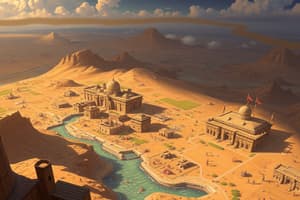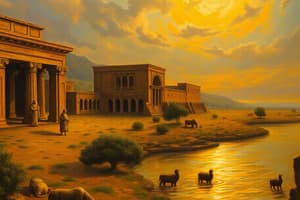Podcast
Questions and Answers
What was the primary factor that contributed to the development of irrigation and agriculture in the Fertile Crescent?
What was the primary factor that contributed to the development of irrigation and agriculture in the Fertile Crescent?
- Availability of metal tools
- Discovery of pottery
- Invention of the plow
- Fertile soil found near the rivers (correct)
What was the significance of the Fertile Crescent in the development of agriculture?
What was the significance of the Fertile Crescent in the development of agriculture?
- It was the region where the plow was invented
- It was the region where agriculture was first developed (correct)
- It was the only region where agriculture was invented
- It was the region where cattle manure was first used as fertilizer
Which of the following was NOT a result of the development of agriculture in the Fertile Crescent?
Which of the following was NOT a result of the development of agriculture in the Fertile Crescent?
- Development of storage facilities
- Exchange of culture and ideas
- Advancements in the region
- Reduced travel and trade (correct)
What was one of the natural methods of fertilizing the soil used by early farmers?
What was one of the natural methods of fertilizing the soil used by early farmers?
What was the term used to refer to Africa, Asia, and Europe?
What was the term used to refer to Africa, Asia, and Europe?
What was one of the innovations that developed in response to agricultural needs?
What was one of the innovations that developed in response to agricultural needs?
What was the long history of human activity that preceded the development of agriculture?
What was the long history of human activity that preceded the development of agriculture?
Which of the following was a result of the exchange of culture and ideas in the Fertile Crescent?
Which of the following was a result of the exchange of culture and ideas in the Fertile Crescent?
What was the primary source of protein for Early Stone Age man?
What was the primary source of protein for Early Stone Age man?
What was a significant consequence of the transition to agriculture?
What was a significant consequence of the transition to agriculture?
What term is commonly used to refer to Africa, Asia, and Europe?
What term is commonly used to refer to Africa, Asia, and Europe?
What was an important trait in the development and spread of human societies?
What was an important trait in the development and spread of human societies?
What was a result of the invention of tools, wood, and fire?
What was a result of the invention of tools, wood, and fire?
What was a characteristic of early human societies?
What was a characteristic of early human societies?
What was a consequence of the shift towards agriculture?
What was a consequence of the shift towards agriculture?
What was the basis of advanced civilization in both the Old and New Worlds?
What was the basis of advanced civilization in both the Old and New Worlds?
What percentage of mankind's existence on Earth has been as a hunter and gatherer?
What percentage of mankind's existence on Earth has been as a hunter and gatherer?
What is the period called when agriculture began to develop?
What is the period called when agriculture began to develop?
What was a major reason for the development of modern medicine, refrigerators, computers, and internet?
What was a major reason for the development of modern medicine, refrigerators, computers, and internet?
During which period did chipped stone tools and weapons start to be made?
During which period did chipped stone tools and weapons start to be made?
How did humans survive before the advent of agriculture?
How did humans survive before the advent of agriculture?
What is the name of the species that has existed for about 195,000 years?
What is the name of the species that has existed for about 195,000 years?
What was the result of the development of agriculture?
What was the result of the development of agriculture?
What was the final period of human history, where agriculture became well developed?
What was the final period of human history, where agriculture became well developed?
Flashcards are hidden until you start studying
Study Notes
The Fertile Crescent
- The Tigris and Euphrates rivers regularly flooded the region, making the soil fertile and suitable for agriculture.
- The Nile River also runs through part of the region, providing access to water for farming and trade routes.
Development and Spread of Agriculture
- Farming developed first in the Fertile Crescent, where barley and wild wheat were abundant.
- Agriculture then spread to parts of Asia, Africa, and Europe.
- Agriculture was invented separately in the Americas around 5000 B.C.
Gradual Progression in Civilization
- The invention of the plow marked a significant progress in agriculture.
- People discovered natural methods of fertilizing the soil, including the use of cattle manure.
- The periodic cultivation of pod vegetables enriched the soil with nitrogen.
Agriculture Prompted New Ideas and Techniques
- The need for storage facilities led to the development of basket-making, pottery, and grinding stones.
- Agricultural needs also encouraged the development of science, particularly in understanding weather and flooding.
- The discovery of metal tools further supported the growth of civilization.
The Old and New Worlds
- The term "Old World" refers to Africa, Asia, and Europe (Afro-Eurasia).
- The term "New World" refers to North America, South America, and Australia.
Civilization and Plants
- Civilization refers to a complex human society, where people live in settled dwellings comprising cities.
- Plants are essential to human civilization, providing food, fodder, shelter, clothing, and more.
- Agriculture allowed humans to have spare time to develop modern technologies, such as medicine, refrigerators, computers, and the internet.
Palaeolithic or Old Stone Age
- The human species, Homo sapiens, has existed for around 195,000 years.
- For most of that time, humans survived by gathering wild plants and hunting animals in their natural environment.
- The Palaeolithic or Old Stone Age lasted for about 10,000 years, with no agriculture, but with chipped stone tools and weapons.
Mesolithic or Middle Stone Age
- The Mesolithic or Middle Stone Age was a period of transition when agriculture began.
- It lasted for several thousand years.
Neolithic or New Stone Age
- The Neolithic or New Stone Age saw the development of well-established agriculture.
- Agriculture continued to expand with the use of metals, up to the present day.
Paleolithic Societies
- Early Stone Age man relied on berries, nuts, and roots for food.
- The emergence of farming resulted in a whole new way of living, with people living in settled communities and growing crops or raising animals on nearby land.
Studying That Suits You
Use AI to generate personalized quizzes and flashcards to suit your learning preferences.




